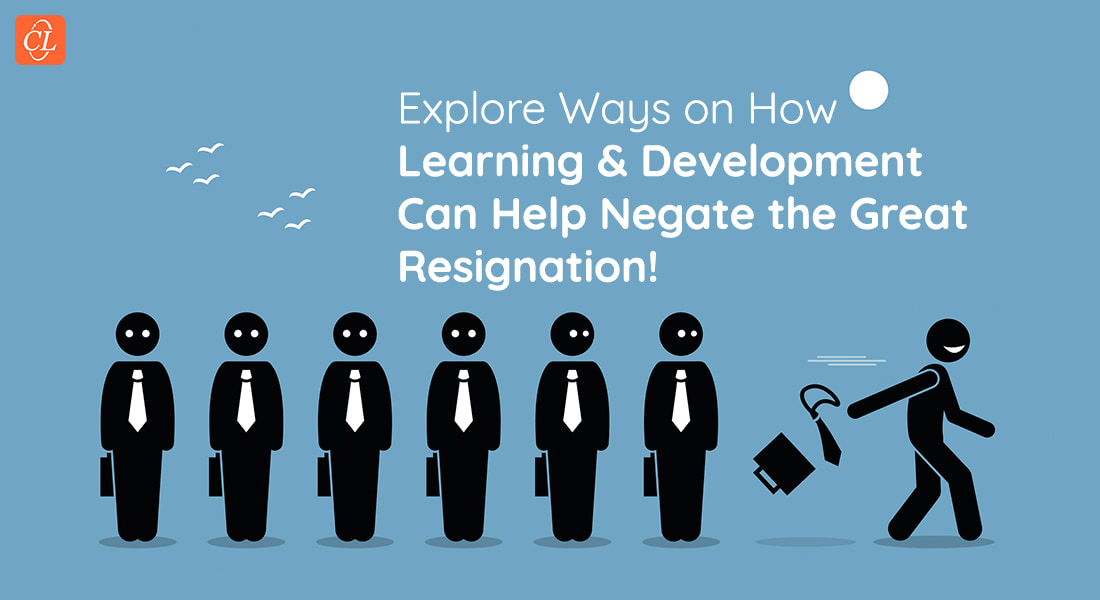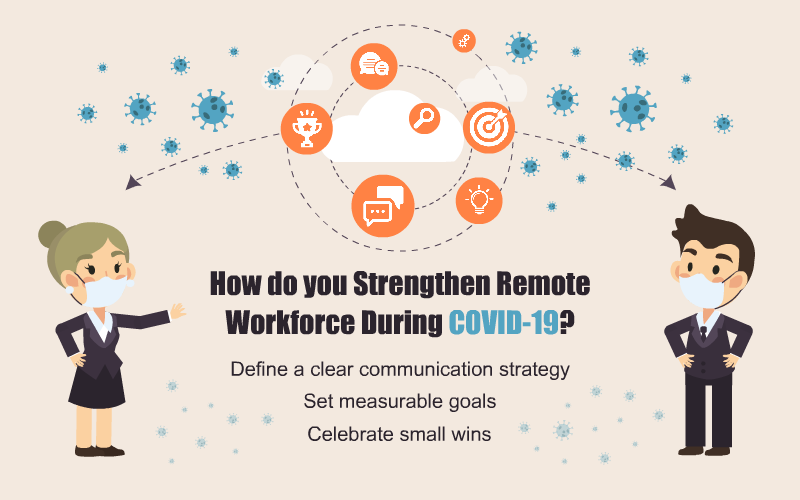How Can L&D Help Negate the Great Resignation?

If you’ve been following the recent developments in the business world, you’ve probably come across the term “The Great Resignation.” The COVID-19 pandemic changed how, when, and where we work. It sparked a global change in perception, leading to millions of employees reevaluating their priorities and putting their health and satisfaction above anything else.
With a rapid shift in beliefs about what constitutes a good job, organizations are revamping their strategies and making learning & development their secret weapon against the Great Resignation to increase retention and satisfaction.
In this post, we’ll discuss the Great Resignation in the post-pandemic age and share how L&D teams can help negate or stop its impact.
The Great Resignation is a Major Concern for Corporates These Days.
Here’s why:
- Demand for a lucrative paycheck to combat inflation
- Flexibility and comfort: Remote or hybrid work models
- Toxic corporate culture
- Job insecurity
Read on to find out how learning and development can help combat the situation.
A Quick Recap of the Great Resignation
The Great Resignation, also known worldwide as the Great Reshuffle or the Big Quit, is a pandemic-induced economic trend in which employees from different countries and industries resign from their workplaces in record volumes.
In the US alone, nearly 47 million people quit their jobs in 2021, with monthly resignations reaching as high as 4.5 million in November, according to the Bureau of Labor Statistics. A 2021 report by Microsoft suggests nearly 41% of the national workforce is considering a job switch to meet their monetary and non-monetary needs.
As a result, there’s a surplus of jobs in the market for the first time in decades, with retailers facing extreme difficulty hiring, onboarding, and retaining talent. Many analysts have termed this period a workers’ revolution or uprising against toxic work cultures, excessive workloads, rigid structures/policies, and inadequate pay/benefits.
To sum up, job seekers are now in control of the landscape for the first time. Thus, employers need to revamp their business strategies and restructure different aspects of their operations and culture to be considered a good workplace.
Are you ready to onboard the millennial workforce? Explore proven tips for an effective online millennial onboarding program.
Understanding Why People Are Quitting
With recruitment, onboarding, and corporate training costs rising, companies need to understand why people are quitting so they can address the needs of their existing workforce for better retention and attract the best talent in the market.
While the Great Resignation period has been nothing short of an alarming period for companies, this pandemic-induced trend has also provided great opportunities for them to take advantage of the situation.
Here are four reasons for the mass exodus:
1. Money
With inflation levels at a 40-year high, many employees are prioritizing higher pay and switching to the highest bidder to make ends meet. Many industries, such as Cybersecurity, digital marketing, online retail, delivery services, etc., have seen a rapid increase in demand. As a result, many companies are tweaking their pay scales to attract the best talent.
2. Flexibility and Comfort
One of the biggest drawbacks of conventional work routines was the lack of flexibility. With remote work transforming how we work and offering a better work-life balance, many employees don’t want things to go back to how they were. For instance, according to a study by Buffer, 98% of respondents claimed they want to work remotely for the rest of their careers.
Thus, one of the reasons businesses are seeing a huge turnover is the return of in-office operations and rigid schedules. Moreover, due to the new habits developed during the pandemic, many workers don’t want to spend hours commuting to and from work. Some have even relocated to different parts of the country or the world and would rather switch than go back to the office.
3. Toxic Corporate Culture
Apart from new work habits and better pay, the biggest reason people quit the workforce is the toxic corporate culture. In the new normal, employees are quitting organizations failing to promote diversity, equity, and inclusion in the workplace. They’re finally standing up against unethical behavior, poor management, pigeonholing, disrespect, and discrimination.
4. Job Insecurity
Due to the looming uncertainty, it’s unsurprising to have employees looking out for themselves and searching for new jobs during difficult times within an organization. In many cases, people quit only for survival after learning about the negative assessments of their company’s future outlook.
The Role of L&D in Negating the Great Resignation
The core function of learning & development teams is to fill knowledge gaps by creating learning solutions to help employees improve their capabilities and performance. Thus, they’re the most equipped department within any organization that can step up during this transition period to help negate the effects of the Great Resignation.
L&D has a tremendous impact on increasing employee retention. It shows employees that the organization is invested in their professional development. Therefore, if you’re looking to retain your talent, you should start by building a strong learning culture from the get-go.
Whether through traditional in-classroom sessions or the adoption of powerful rapid eLearning development tools, such as Adobe Captivate or iSpring, upskilling or reskilling employees can help build a clear career path that entices them to stay longer and help your organization achieve its financial or growth goals.
Moreover, it can enable internal mobility, especially in remote or hybrid environments, so employees don’t feel they need a change of pace or environment to fulfil their career goals.
Here’s how L&D can help negate the Great Resignation and improve workplace satisfaction and retention:
1. Onboarding
As expected, mass resignations in 2021 have increased the need for mass recruitment. While this may look like a great burden on L&D teams, it presents a great opportunity for them to restructure your onboarding strategy to deliver more meaningful experiences for employees joining your company.
This mainly includes leveraging the right tools and processes to engage employees faster and more efficiently. For instance, they can adopt programs that digitize recruitment paperwork or create checklists of onboarding activities, so employees know what to expect.
They can also use authoring tools with assessment features, such as quiz builders, scenario and simulation-based learning, gamified content, etc. Modern solutions like Articulate 360 can help enhance the onboarding process and make the transition more enjoyable for new employees.
Plus, they can use real-time communication features to share feedback, enabling L&D teams to use their actionable insights to make relevant changes instead of relying solely on third-party research.
2. Knowledge Management
With employees leaving en masse, especially highly skilled and experienced ones, L&D teams have a huger responsibility on their shoulders to fill the knowledge hole in their organization. They can develop corporate training programs to upskill or reskill employees to take on those roles with the right solutions and strategy.
By taking a blended learning approach, you can develop detailed eLearning courses for every department or business function, such as sales, marketing, IT, leadership, etc., and host in-person/VILT sessions to curb confusion. Moreover, apart from depending on information recall, L&D teams can leverage microlearning videos, infographics, and interactive PDFs to enable Just-in-Time learning.
This way, teams can access the information they need to carry out tasks and activities instead of relying on their retention skills at all times. The materials can accelerate learning and help your company fill the knowledge gaps and roles faster, often without hiring new employees.
3. Upskilling and Reskilling as a Non-Monetary Benefit
Another way L&D teams can help reduce resignations and improve retention is by developing corporate training programs to prepare them for better roles and bigger pay. By offering training as a non-monetary benefit, you can encourage young employees to stick around longer and improve their capabilities.
You can achieve your business goals and increase revenue in return for your investment. At the same time, you can reward the employees who helped you get to where you needed to go by offering them more important responsibilities and better pay. This scenario is a win-win for all parties involved.
Bottom Line
So, there you have it – three ways learning & development teams can help stop or negate the effects of the Great Resignation. Corporate training and development has become one of the main priorities for businesses looking to transform their operations and adopt new solutions and practices.
However, organizations can use it to boost employee retention and satisfaction. Acquiring new knowledge and skills has become a necessity in the new normal. Thus, organizations investing in employee development programs are naturally becoming more attractive for the fluid workforce.
Are you looking forward to taking your corporate training to the next level? Join LearnFlux, a virtual learning event to gain insights on what’s trending in the corporate L&D space.




![Insider’s Guide for L&D Pros to Building a High-Performing Hybrid Employee Learning Strategy [eBook]](https://blog.commlabindia.com/hubfs/Imported_Blog_Media/LD-professionals-Heres-a-Guide-to-Build-High-Performing-Hybrid-Employee-Learning-Strategy-eBook-min-1.png)
![Get Your Boss to Say YES for eLearning – Build a Winning Business Case [Infographic]](https://blog.commlabindia.com/hubfs/Imported_Blog_Media/elearning-business-case-info.jpg)